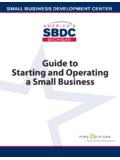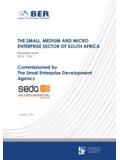Transcription of SMALL BUSINESS/ SELF- EMPLOYED
1 (fold)(fold)(fold)Where Can I Go For Help? Telephone: Order free copies of all IRSforms and publications by calling1-800-829-3676 (1-800-Tax-Form).Excellent Publications for SMALL Businesses: business Resource Guide (CD-ROM),Publication 3207. At A Glance, Publication 3698If you have questions, contact your tax prepareror the IRS 24 hours a day, seven days a weekat 1-800-829-1040 (1-800-Tax-1040). On the Internet: Access the IRS Web Sitefor federal tax forms, publications, tax lawchanges, and other tax information for individu-als and businesses on the Internet more information specific to the construc-tion industry, go to: , Under Contents click on Industries/Professions. Click on, Construction. The construction industry can benefit by usingthe IRS e-file program. Returns are processedmore quickly, accurately and an electronicacknowledgement is sent with each returnreceived.
2 Forms 940/941, 1065, and informa-tion returns (Forms 1042-S, 1098,1099,5498,8027, W-2G and QWF (Questionable FormsW-4) can be electronically filed. Beginning in2004, Forms 1120/1120S will be available. for a list of approved IRS all of your Federal business and individualtaxes through the Electronic Federal PaymentSystems (EFTPS). It is a free service and youcan make your payments 24 hours a day 7days a week by phone or through the more information call EFTPS CustomerService at 1-800-555-4477 or 1-800-945-8400or visit our website at Internal Revenue Service hasidentified several issues that maycause problems for the owners ofsmall construction document is intended to makeyou aware of these issues and toprovide you with information, whichwill help you avoid pitfalls along issues include: Accounting Methods Capitalization of Indirect Coststo Long-Term Contracts Independent Contractor orEmployee ClassificationWhether you have an existing busi-ness or just starting one, we want tohelp you understand and complywith the tax laws that affect recognizing the significance ofthese issues, SMALL constructionbusiness owners can properly filetheir tax returns and avoid costlyproblems.)
3 Accounting Method IssuesAccounting methods are not always acontractor s choice in the construction contractors who use the cash method ofaccounting may be required to use an are Accounting Methods? An accounting method is a set of rules todetermine when and how income andexpenses are reported. It includes notonly the overall method but also theaccounting treatment of any material of accounting methods are cashreceipts and disbursements, accrual, andcombinations of such methods. Whichevermethod is elected, it must clearly reflectincome. If your business operates as a C corpora-tion with gross receipts in excess of $5million, you generally are required to usean accrual method of accounting. If an inventory method is required becausemerchandise (or materials) is an income-producing factor in the business , generally,an accrual method must be used forpurchases and sales.
4 An exception to the requirements to usean accrual method and to account forinventories is found in Revenue Procedure2002-28, which permits most smallbusinesses with average annual grossreceipts of $10 million or less to use thecash method of accounting. However, ataxpayer otherwise required to use theaccrual method cannot qualify for thisexception. In addition, a business whoseprincipal activity is mining, manufacturing,wholesale trade, retail trade or informationindustries will generally be ineligible to usethis exception. (See Rev. Proc. 2001-10).The accounting of inventory items issimplified by The Revenue Procedureallowing their cost to be deducted in theTAX INFORMATION FORSMALL CONSTRUCTIONBUSINESSESSMALL BUSINESS/ self - EMPLOYEDINTERNAL REVENUE SERVICEC onstructionSpecialization ProgramWhen it comes toworking harder for you,consider it donePublication 3780 (Rev.)
5 11-2003)Catalog Number 31997W(fold)(fold)(fold)year the merchandise is sold or paid for,whichever is later. Generally the percentageof completion method is required for long-term contracts. A long-term contract is onethat is still in process at the end of yourtaxable year. For example, if work on acontract to construct a building begins inNovember 2000, and ends in January2001, and the contractor used the calendartax year, the contract is a long-term con-tract. Home construction contracts are notsubject to the percentage-of-completionmethod. In addition, general constructioncontracts are not subject to the percentageof completion method if certain completiontime and gross receipts tests are all these exempt construction contracts,a taxpayer may use an exempt contract method, which includes the percentage ofcompletion method, the exempt-contractpercentage-of-completion method, thecompleted contract method, or any otherpermissible method.
6 Whether a method is permissible dependson a number of factors, such as the type ofbusiness entity, business activity, level ofgross receipts, and existence or absence ormerchandise as an income-producingfactor in the Cost IssuesContractors are required to allocate indirect jobcosts to their long-term contracts annuallyunless the Code or regulations provide other-wise. Whether contractors are required tocapitalize these allocable job costs, or arepermitted to deduct these allocable job costs,depends on the contractor s method of account-ing for long-term contracts. Allocable job costs include costs that areincurred because of the contractor sconstruction projects, such as repairs,equipment maintenance and rentals,utilities at the job site, depreciation onconstruction equipment, officer s compen-sation, and workers compensation insur-ance.
7 Non-allocable job costs included expensesfor unsuccessful bids and proposals and formarketing, selling, and advertising ex-penses. These costs are exempted fromthe cost allocation requirement. In general, contractors using the percent-age of completion method are required toallocate indirect job costs to their long-termcontracts. Contractors using the com-pleted contract method of accounting arerequired to capitalize indirect job costsallocated to long-term contracts until thecontract is is the Capitalization of Indirect Costsan Important Issue?Many contractors utilizing the completedcontract method of accounting overstate theirdeductions because they are not properlyallocating costs to long-term contracts. Underthe completed contract method, income or lossis reported in the year in which the contract iscompleted. In addition to direct materials andlabor costs, all indirect costs incurred for reasonof a long-term contract or that directly benefitthe long-term contract, must be allocated, orcapitalized to that contract.
8 As long as thatcontract has not been completed and accepted,these costs must not be deducted as currentperiod indirect costs may benefit both the long-term contract and other business costs will require a reasonable allocationbetween the other business activities and thelong-term contract. Suggested methods arespecific identification method or the use ofratios based on direct costs, hours, or otherunits of Contractor orEmployee Classification IssuesBefore you can know how to treat paymentsyou make for services, you must first know thebusiness relationship that exists between youand the person performing the services. Theperson performing the services may be anemployee or an independent three factors to consider when making thisdetermination are: Behavioral Control Financial Control Relationship of the PartiesAudit Technique GuidesAudit Technique Guides contain examinationtechniques, common and unique industry issues, business practices, industry terminology, andother information.
9 There are several of theseguides specific to construction, which may helpyou understand your industry. They can befound at Click on Indus-tries/Professions, Click on American Industry Classifica-tion System (NAICS)When preparing your tax return, you should referto the instructions for each return type ( , Form1040, Schedule C, Form 1120, 1120S, or 1065)for the proper NAICS code that most accuratelydescribes your particular business construction codes are provided forBuilding, Developing, General Contracting,Heavy Construction, and Special Trade Contrac-tors:Building, Developing, and General Contracting233110 Land Subdivision and Land Development233210 Single Family General Construction ContractorsHeavy Construction234100 Highway and Street ConstructionSpecial Trade Contractors235110 Plumbing, Heating, & Air Conditioning235210 Painting & Wall Covering Contractors235310 Electrical Contractors235410 Bricklaying Construction Contractors235610 Roofing, Siding, and Sheet MetalFurther information can be found in Accountingperiods and Methods, Publication 538, InternalRevenue Code Sections 446, 448, 460, and theirrespective Treasury information is contained in TreasuryRegulation and IRC section 263A for certaincontractors such as large home constructioncontracts.
10 Contractors required to use thepercentage of completion method for long-termcontracts should refer to IRC Section information can be found in Employer sSupplimental Tax Guide, Publication 15-A.














